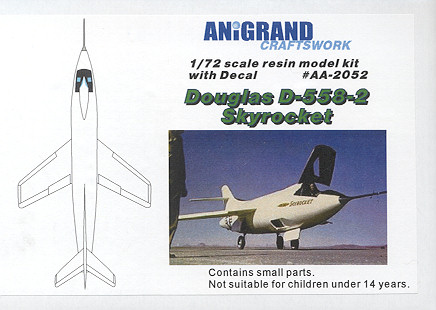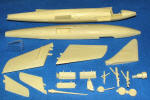
| KIT: | Anigrand Craftworks 1/72 D.558-2 Skyrocket |
| KIT #: | AA-2052 |
| PRICE: | $33.00 from Nostalgic Plastic (free US shipping) |
| DECALS: | One option |
| REVIEWER: | Scott Van Aken |
| NOTES: | Short run resin kit with vac canopy |

| HISTORY |
In fall of 1944, U.S. Navy ordered six D-558-1 Skystreak in order to research the transonic speed flight. After the end of the war, with captured data of German swept-wing research, three of the ordered Skystreak were replaced with swept-wing design which became the D-558-2 Skyrocket. Differed from the D-558-1, the D-558-2 was installed with rocket engine and air-launch from Boeing P2B (B-29). First flight of the first D-558-2 was take off from ground by it own turbojet power in 1948. After gathered data about characteristics of swept-wing aircraft, all the three D-558-2 was replaced or installed rocket engine for the high speed flight research by air-launching. In 1951, it set a new world record an altitude of 79494 feet. In 1953, the second D-558-2, with minor modification of the power configuration, became the first aircraft to reach Mach 2. The D-558-2 Skyrockets were flown until 1956 and then being retired.
| THE KIT |
 This is the second of the triumvirate of Douglas experimental aircraft, and probably the one that is most recognized by the average aviation enthusiast. The kit is of the final version that operated on pure rocket power so there is no engine intake or jet exhaust provided. The box top and photo in the instructions is somewhat misleading as it implies the turbojet powered version, and while that would have been a nice one to have, the rocket powered one is fine, too.
This is the second of the triumvirate of Douglas experimental aircraft, and probably the one that is most recognized by the average aviation enthusiast. The kit is of the final version that operated on pure rocket power so there is no engine intake or jet exhaust provided. The box top and photo in the instructions is somewhat misleading as it implies the turbojet powered version, and while that would have been a nice one to have, the rocket powered one is fine, too.
Molded in Anigrand's usual tan resin with large engraved panel lines, this one has little in the way of molding glitches, aside from some holes in one wing tip. The luck of the draw on this one. There is space in the nose for weight as it will be needed on this one. The cockpit is nothing like the one in the real aircraft with little more than a generic seat and a straight stick to fit in there. One vacuformed canopy is provided and one should leave this closed, which further hides what can be seen of the interior. Anigrand does provide the correct shaped rocket nozzle, though it is, of course, a bit on the simplistic side.
Instructions are the usual exploded view, parts list and history on one side with markings and painting guide on the other. Now here comes the difficult part. The large serial number and the 'Skyrocket' logo were only used on Skyrocket #1 when it was totally turbojet powered. In this instance you'd need to carve out the jet intake and exhaust and put a cone on the tail section where the rocket exhaust would be. By the time the D.558-II was flying on full rocket power, the name and largish serial were gone.
 The aircraft that was flown the most on pure rocket power was serial 37974. It made 7 short flights under Navy guise before being turned over to NACA for all the rest of the record breaking speed and altitude flights. That means that unless you can come up with NACA markings (which do not include the NAVY decal or insignia, then you are severely limited to what decals you can use from this sheet for the D.558-II. What it boils down to is that you'll need to alter the serial number from the one given for the #1 aircraft, and then you can use the NAVY and insignia for those few flights performed by the military pilots before NACA got hold of it. You cannot use the "Skyrocket" markings at all with this kit and stay accurate to history.
The aircraft that was flown the most on pure rocket power was serial 37974. It made 7 short flights under Navy guise before being turned over to NACA for all the rest of the record breaking speed and altitude flights. That means that unless you can come up with NACA markings (which do not include the NAVY decal or insignia, then you are severely limited to what decals you can use from this sheet for the D.558-II. What it boils down to is that you'll need to alter the serial number from the one given for the #1 aircraft, and then you can use the NAVY and insignia for those few flights performed by the military pilots before NACA got hold of it. You cannot use the "Skyrocket" markings at all with this kit and stay accurate to history.
I'm sure there are some of you who wish I'd not brought this to your attention, but when one has the knowledge, it is only right to pass it along so that the reader can make the choice. Fortunately, Cutting Edge has a great sheet full of NACA and NASA markings that should work if you want to do Scott Crossfield's Mach 2 mission. Sadly, Scott Crossfield died in an aircraft accident on 20 April 2006. He was 84 years old.
| CONCLUSIONS |
OK, this is yet another great kit for the X-Plane crowd. I know I like seeing it and it will give me an excuse to put away the old Revell kit I've been working on for years!
An outstanding reference on this aircraft isSpecialty Press' "Skystreak, Skyrocket and Stiletto" that was published last year.
Many thanks to Nostalgic Plastic, the US importer, for the review kit.
If you would like your product reviewed fairly and quickly by asite that has over 300,000 visitors a month, please contactme or see other details in the